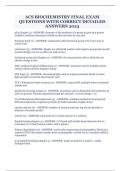Zwitterion 3 - Study guides, Class notes & Summaries
Looking for the best study guides, study notes and summaries about Zwitterion 3? On this page you'll find 49 study documents about Zwitterion 3.
Page 2 out of 49 results
Sort by

-
ACS Biochemistry Final (100% Correct Answers)
- Exam (elaborations) • 5 pages • 2023
-
Available in package deal
-
- $11.49
- + learn more
pKa (chapter 3) correct answers measure of the tendency of a group to give up a proton (acidity); tendency decreases tenfold as pKa increases by one unit thioester bond (1) correct answers compounds with functional group C-S-CoA-C (eg, in acetyl-CoA) zwitterion (3) correct answers dipolar ion with both positive and negative groups but overall neutral charge; can act as either an acid or base Isoelectric point (pI) (chapter 3) correct answers the characteristic pH at which the net electr...
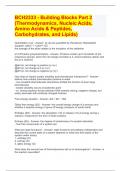
-
BCH2333 - Building Blocks Part 2 (Thermodynamics, Nucleic Acids, Amino Acids & Peptides, Carbohydrates, and Lipids) Q's & A's
- Exam (elaborations) • 13 pages • 2024
-
- $8.99
- + learn more
BCH2333 - Building Blocks Part 2 (Thermodynamics, Nucleic Acids, Amino Acids & Peptides, Carbohydrates, and Lipids) Quantitation of pI - Answer- pI can be quantified by Henderson-Hasselbalch equation: (pKa^-1 + pKa^+1)/2 the average of the pKas relates to the ionization of the zwitterion pI of Proteins (polyampholytes) - Answer- Proteins contain up to hundreds of pH-responsive groups; when the net charge of protein is 0, anions balance cations and the pI is reached @pH<pI, net charg...

-
ACS Biochemistry Final Exam Questions with All Correct Answers
- Exam (elaborations) • 6 pages • 2023
-
Available in package deal
-
- $12.39
- + learn more
ACS Biochemistry Final Exam Questions with All Correct Answers pKa (chapter 3) - ANSWER measure of the tendency of a group to give up a proton (acidity); tendency decreases tenfold as pKa increases by one unit thioester bond (1) - ANSWER compounds with functional group C-S-CoA-C (eg, in acetyl-CoA) zwitterion (3) - ANSWER dipolar ion with both positive and negative groups but overall neutral charge; can act as either an acid or base Isoelectric point (pI) (chapter ...

-
ACS Biochemistry 2023-2024 Final (100% Correct Answers)
- Exam (elaborations) • 5 pages • 2023
-
Available in package deal
-
- $10.99
- + learn more
pKa (chapter 3) correct answers measure of the tendency of a group to give up a proton (acidity); tendency decreases tenfold as pKa increases by one unit thioester bond (1) correct answers compounds with functional group C-S-CoA-C (eg, in acetyl-CoA) zwitterion (3) correct answers dipolar ion with both positive and negative groups but overall neutral charge; can act as either an acid or base Isoelectric point (pI) (chapter 3) correct answers the characteristic pH at which the net electr...
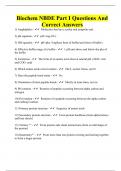
-
Biochem NBDE Part I Questions And Correct Answers
- Exam (elaborations) • 29 pages • 2023
-
- $11.99
- + learn more
1) Amphiphiles - Molecules that have a polar and nonpolar end. 2) pH equation - pH=-log (H+) 3) HH equation - pH=pka +log(base form of buffer/acid form of buffer) 4) Effective buffer range of a buffer - 1 pH unit above and below the pka of the buffer 5) Zwitterion - The form of an amino acid when at neutral pH. (NH3+ end and COO- end) 6) Which amino acids exist in nature - The L isomer forms, not D 7) Does the peptide bond rotate - No 8) Orientation of most pep...
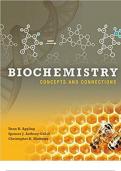
-
Test Bank for Biochemistry Concepts and Connections 1st Edition by Dean R. Appling, Spencer J. Anthony-Cahill & Christopher K. Mathews , ISBN: 9780321839923 |COMPLETE TEST BANK| Guide A+
- Exam (elaborations) • 102 pages • 2024
-
- $10.99
- + learn more
Biochemistry: Concepts and Connections (Appling et al.) Chapter 1 Biochemistry and the Language of Chemistry 1) The water content in the human body is approximately: A) 90%. B) 80%. C) 70%. D) 60%. E) 50%. Answer: C 2) The four most abundant chemical elements in living systems are: A) hydrogen, oxygen, sulfur and phosphorus. B) hydrogen, carbon, nitrogen and oxygen. C) sodium, potassium, carbon and oxygen. D) sodium, potassium, nitrogen and sulfur. E) carbon, nitrogen, oxygen and potassium. Answ...
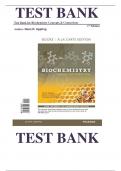
-
Test Bank for Biochemistry Concepts and Connections 1st Edition by Dean R. Appling, Spencer J. Anthony-Cahill & Christopher K. Mathews , ISBN: 9780321839923 |COMPLETE TEST BANK| Guide A+
- Exam (elaborations) • 102 pages • 2024
-
- $19.99
- + learn more
Biochemistry: Concepts and Connections (Appling et al.) Chapter 1 Biochemistry and the Language of Chemistry 1) The water content in the human body is approximately: A) 90%. B) 80%. C) 70%. D) 60%. E) 50%. Answer: C 2) The four most abundant chemical elements in living systems are: A) hydrogen, oxygen, sulfur and phosphorus. B) hydrogen, carbon, nitrogen and oxygen. C) sodium, potassium, carbon and oxygen. D) sodium, potassium, nitrogen and sulfur. E) carbon, nitrogen, oxygen and potassium. Answ...
ACS BIOCHEMISTRY FINAL EXAM QUESTIONS WITH CORRECT DETAILED ANSWERS 2023

-
MCAT Biochemistry Review Exam Questions And Correct Answers
- Exam (elaborations) • 65 pages • 2024
-
- $12.49
- + learn more
©THEBRIGHT EXAM STUDY SOLUTIONS 8/22/2024 12:54 PM MCAT Biochemistry Review Exam Questions And Correct Answers Amino Acid - answerDipolar compound containing an amino group and a carboxyl group Amino Group - answer-NH2 Carboxyl Group - answer-COOH Alpha Carbon - answerCentral carbon atom in amino acid Attached to amino & carboxyl groups, H atom, and side chain Side Chain - answerThe variable component of an amino acid that gives the amino acid its identity and chemical properties also...
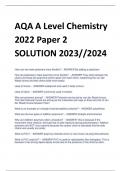
-
AQA A Level Chemistry 2022 Paper 2 SOLUTION 2023//2024
- Exam (elaborations) • 5 pages • 2024
- Available in package deal
-
- $11.49
- + learn more
AQA A Level Chemistry 2022 Paper 2 SOLUTION 2023//2024 How can we make polymers more flexible? - ANSWER By adding a plasticiser How do plasticisers make polymers more flexible? - ANSWER They stick between the chains and keep the polymers further apart from each other, weakening the van der Waals forces and lets chains slide more easily. Uses of Kevlar - ANSWER bulletproof and used in body armour. Uses of Nylon - ANSWER commonly used in textiles. Why are polymers strong? - ANSWER Poly...

How much did you already spend on Stuvia? Imagine there are plenty more of you out there paying for study notes, but this time YOU are the seller. Ka-ching! Discover all about earning on Stuvia



